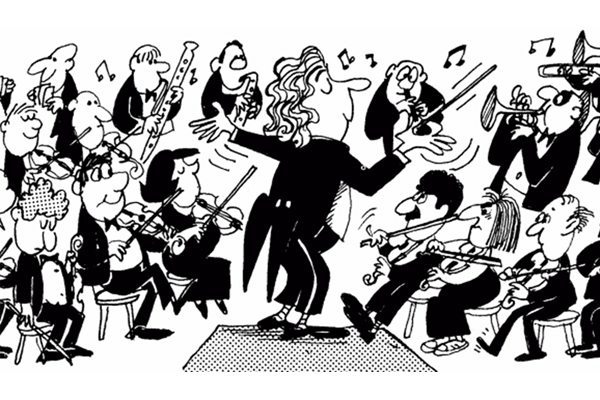The Symphony of Teamwork
Table of Contents
When we hear the word “team,” we tend to think of the usual suspects—sports teams, perhaps a successful startup, or maybe even a high-performing department in an organization. But if I were to choose a less conventional example, I would say, look to the orchestra. Yes, the symphony orchestra. A place where dozens of musicians, playing wildly different instruments, come together to create harmony.
It may seem like an odd comparison at first. After all, the world of business does not often overlap with the world of music. But when you pay close attention to how an orchestra functions, it starts to sound like a masterclass in collaboration, leadership, and emotional intelligence.
As a lifelong lover of music and someone who has spent a fair bit of time observing teams across corporate settings, I have come to realize that the orchestra is a near-perfect metaphor for the kind of workplace we aspire to build, where different departments, personalities, and skill sets work in harmony toward a shared goal.
So allow me to take you into the concert hall for a moment, where leadership is silent but visible, where every player knows their role, and where success depends on both preparation and presence. Here are four powerful lessons from the orchestra that can transform the way we think about teams.
1. Rehearse in Groups, But Perform as One
Musicians rarely, if ever, walk into a concert and play a piece perfectly on the first try. What we see on stage is the result of dozens of sectional rehearsals. Strings, brass, woodwinds, and percussion all meet in their own clusters to work through their parts, adjust dynamics, and solve technical challenges. Each section finds its voice before they come together.
This is a lesson every team can take to heart.
While we may work in departments or functions, success often requires us to operate as a unified whole. Sales and marketing cannot function in silos. Product development must understand customer insights. HR must sync with leadership to support culture-building initiatives.
At one offsite I facilitated, we broke up cross-functional teams into smaller “sections,” giving each the same challenge but different constraints. They had to first solve the problem within their group, then come together to create a shared solution. What emerged was a powerful realization—each group had a strength, but without integration, no single idea was complete.
Much like in an orchestra, the sections of a company must understand each other’s rhythms and create space for mutual support. This can be developed intentionally through inter-team activities such as team building experiences that simulate cross-functional collaboration.
What to apply:
- Create time for department-specific work, but regularly bring the whole team together
- Rotate ownership of joint projects to promote shared accountability
- Celebrate the ensemble, not just the soloist
A great team is not just a collection of talent. It is a collaboration of intentions.
2. Practice Alone to Contribute Better in Groups
Behind every polished performance lies countless hours of individual practice. Violinists run through their scales. Percussionists rehearse transitions. Pianists train their fingers until the movement becomes muscle memory. This work happens in solitude, away from applause.
In organizational settings, we often undervalue individual preparation. The reality is, the best team players are also great solo performers. Not because they crave the spotlight, but because they show up ready. They bring clarity of thought, sharpened skills, and a sense of personal responsibility.
I have seen this play out in project teams where someone quietly puts in the time to understand the data, prep a draft, or brainstorm ideas in advance. When the group meets, their preparation lifts the conversation. It sets a higher bar, not by force, but by example.
This kind of contribution is often invisible but incredibly valuable. It also builds self-confidence, which is essential for teams navigating uncertainty.
As part of leadership development programs, I often encourage people to block solo thinking time into their calendars. Whether it is journaling, research, or even a quiet walk, solo practice nurtures creativity.
If you want to help your team develop that mindset, check out experiential sessions like Personal Effectiveness Workshops which focus on self-awareness, goal clarity, and structured reflection.
What to apply:
- Encourage preparation before meetings, especially for brainstorming sessions
- Give people space for deep work by reducing unnecessary syncs
- Recognize silent contributors who uplift team outcomes
Personal mastery is the foundation of team excellence.
3. Know When to Solo and When to Accompany
In a concert, there is always a moment when the flute takes over, or the cello introduces a quiet melody. But what makes that solo impactful is the way the rest of the orchestra supports it. Sometimes they pause completely. Other times they play gently underneath, creating contrast and depth.
This balance of stepping up and stepping back is one of the most essential skills in both music and leadership.
In teams, we often assume that leaders must always lead. That every decision must come from the top. But truly adaptive leaders know when to pass the baton. They understand when a team member has a better idea, or when another department is better equipped to handle a particular challenge.
This humility is not a weakness. It is a sign of trust.
Similarly, employees must learn when to take the lead and when to support. Not every project requires you to shine. Sometimes your greatest contribution is in helping someone else succeed.
This lesson came alive during a simulation I ran for a leadership cohort, where each person had to alternate between leading, supporting, and observing. Those who embraced the flexibility found themselves learning faster, and more importantly, earning the trust of their peers.
If you are looking to instill this dynamic in your team, explore experiential programs like Situational Leadership Simulation, where participants rotate roles in real-time and experience the impact of collaborative agility.
What to apply:
- Create a culture where different people take the lead on different topics
- Reinforce the value of listening and supporting, not just driving
- Appreciate those who amplify others without seeking credit
The best teams are not led by one loud voice. They are lifted by many willing hands.
4. The Conductor Sets the Tone, But the Music Belongs to the Team
Perhaps the most fascinating figure in the orchestra is the conductor. They do not play an instrument, yet they are essential to the music. Their gestures guide tempo, mood, and transitions. They shape the interpretation of the piece. But once the performance begins, they rely completely on the players to bring it to life.
This is leadership at its most refined.
A good conductor does not micromanage. They prepare, guide, and inspire. During the performance, they trust their musicians. And when the audience applauds, the conductor always turns around and gestures toward the orchestra, acknowledging the team.
In the workplace, we need more conductors and fewer controllers. Leaders who understand that their role is to create clarity, not dependency. To draw out potential, not dictate performance.
I once worked with a manager who began every team meeting by asking, “What do you need from me today to do your best work?” That simple question reframed leadership as service. Over time, it led to higher morale, better performance, and lower attrition.
For leaders looking to grow in this area, consider programs like Manager Capability Development that focus on practical frameworks for coaching, delegation, and team empowerment.
What to apply:
- Clarify vision and goals, then let the team choose their path to delivery
- Provide feedback that is specific, timely, and encouraging
- Publicly share credit, privately offer guidance
Leadership is not about being the loudest voice. It is about helping others find their voice.
Final Takeaway: Tune Your Team Like an Orchestra
The next time you attend a live performance, whether it is a full orchestra or just a jazz trio, take a moment to observe the unspoken communication between players. Notice how they make eye contact, adjust their volume, wait for one another. It is not just music. It is teamwork at its finest.
In a world of complexity and rapid change, we do not need more noise. We need more harmony. We need teams that can adapt, listen, lead, and follow. We need leaders who know how to tune a room, not just fill it.
So ask yourself:
- Where does my team need more rehearsal time?
- How am I supporting individual growth alongside team collaboration?
- When do I need to step back and let someone else lead?
If you have ever felt the energy of playing in sync with others, whether in a band, a boardroom, or a brainstorming session, you know how powerful it can be. That experience of flow, trust, and connection is what we all seek.
Music offers us not just entertainment, but insight. And sometimes, all we need to do is listen.





